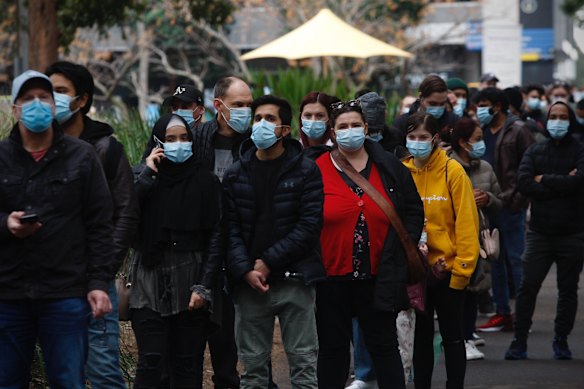This was published 2 years ago
Opinion
Vaccination rates may have peaked: what Scott Morrison does next is critical
By Steven Hamilton and Richard Holden
Credit where it’s due: the Commonwealth has stepped up to the plate in recent months, doing the leg work to secure additional vaccine doses at any cost, as it should have all along. Millions of additional doses from Poland, Singapore and Britain have given the rollout the shot in the arm it needs – so much so that soon supply will outstrip demand.
But the risk now is that the government rolls out the “mission accomplished” banner, passing the buck to Australians to turn up for a jab. In fact, the government’s role is far from over, and what it does next is every bit as critical as anything that came before.

People queuing at Sydney Olympic Park vaccination hub. Credit: Dean Sewell
Not helping matters is our current national obsession with specific vaccine targets which seems to have created a false impression of a finish line at 80 per cent vaccinated (either of the population or those over 16, depending whom you ask), beyond which we can all take a seat, relax and enjoy the summer. Indeed, worryingly, the Prime Minister himself this week described 40 per cent of those eligible (around a third of the population) as the “halfway mark”.
In fact, there’s no such finish line. The only thing we know for sure is more is better – the higher the vaccination rate, the less likely an outbreak will occur and the less severe it will be if it does occur. When Australia gets to 80 per cent of those eligible (around two-thirds of the population), we won’t have won the race, we’ll have qualified for the final. Winning the race requires doing all we reasonably can short of physically pinning people down.
The government’s vax tsar, Lieutenant-General John Frewen, said this week: “Supply isn’t the great challenge now. It really is about people coming forward.” But, of course, the government is yet to announce any policies – besides a decidedly lacklustre ad campaign – to encourage them to do so. This is despite the fact that vaccines are a textbook example of an externality, the solution to which is incentives to drive take-up.
To date the lack of incentives hasn’t mattered much because of significant initial demand and constrained initial supply. But as Frewen says, the imbalance is righting quickly. While our vaccine supplies have been accelerating, our rate of getting jabs in arms has actually begun to flatline in recent weeks. Indeed, without further action our daily jab rate may already have peaked. We’ve been overtaken by New Zealand, and they’re running much faster.
This has little to do with extreme anti-vaxxers, but a lot to do with ordinary folks who procrastinate, are too busy with work or caring responsibilities, or who are simply hesitant. In a recent survey, only 12 per cent of Australians said they weren’t willing to be vaccinated, while 10 per cent said they were simply unsure. While the former might be hard to move, the latter certainly aren’t. The question is how best to do so.
Of concern is that we’re now running into what we’ve called the “vaccine passport paradox”. When more people get vaccinated, case numbers fall, which is good news. But it also reduces the incentive to get vaccinated. NSW Premier Gladys Berejiklian this week previewed a range of freedoms for the vaccinated from next month – but how much longer until they’re extended to everyone anyway?
To the extent this free-rider effect persists, our vaccination rate will remain lower than it should be, leaving us exposed to the risk of another, more severe outbreak. You might think this won’t affect the vaccinated, but think again. Good luck accessing an overwhelmed public health system, and even the vaccinated are at some risk of a breakthrough infection because no vaccine is perfect. And it will inevitably mean the return of public health orders even for the vaccinated.
The way to resolve the paradox is to provide meaningful incentives for vaccine uptake that don’t depend on case numbers. These can take many forms: making it easier to get vaccinated, providing cash payment or lotteries, even private companies offering frequent-flyer points and prizes. The bottom line is we need to do whatever we can to make being vaccinated far more appealing than not being vaccinated.
Our current vaccination targets lay a sensible pathway out of current restrictions. But there’s a real danger of turning interim goals into final targets. The government needs to avoid talking in binary terms, or giving the impression that vaccinating two-thirds of the population means job done. It doesn’t. Just ask the US, Britain or Israel.
Scott Morrison cannot let this be his aircraft-carrier moment.
The Opinion newsletter is a weekly wrap of views that will challenge, champion and inform your own. Sign up here.